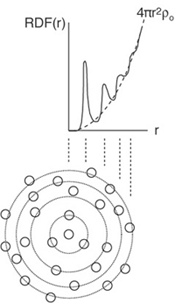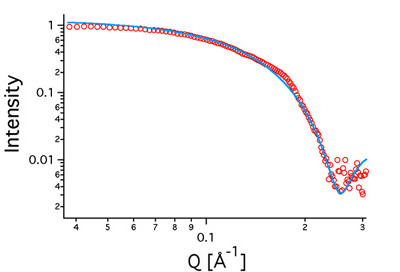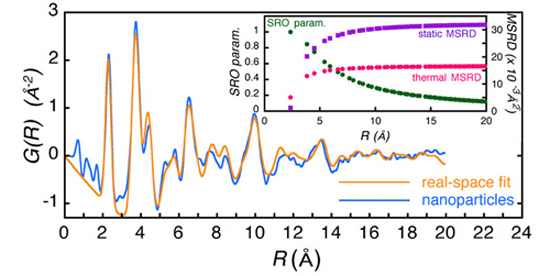
Using synchrotron techniques, Benjamin Gilbert and colleagues in Jill Banfield's group at the University of California - Berkeley and Glenn Waychunas at LBNL have determined how the equilibrium structure and lattice dynamics of zinc sulfide (ZnS) nanoparticles differ from bulk ZnS. They combined size and shape information from small-angle x-ray scattering (SAXS) with structure information from wide-angle x-ray scattering (WAXS) to analyze structural differences in the real-space pair distribution function (PDF). By combining SAXS and WAXS, they were able to remove the small-particle size contribution to x-ray diffraction peak broadening and quantify the excess disorder and strain in the nanoparticles relative to bulk ZnS.
As shown pictorially in Fig. 1, the PDF is the difference in the actual radial distribution (RDF) of a material and that associated with the mean atomic density, 4πr2ρo. Hence, the PDF retains the information on the periodic structure. In nanoparticles, the PDF naturally diminishes to zero as the interatomic distance approaches the nanoparticle diameter. After obtaining nanoparticle size information from SAXS (Fig. 2), the group observed that the PDF terminated more rapidly than could be explained by small particle size alone. This was attributed to a combination of disorder and inhomogeneous strain within the nanoparticle interior. As shown in Fig. 3, they developed PDF fitting routines that enabled these effects to be quantified.

A temperature-dependent extended x-ray absorption fine structure (EXAFS) study of ZnS nanoparticles and bulk ZnS at the Zn K-edge gave insight into how the materials properties of the nanoparticles are affected by their internal distortion. From a fit to the first-shell disorder, they determined that the ZnS nanoparticles were significantly stiffer than bulk ZnS.
The internal disorder was observed despite the presence of strongly bound surface ligands (here, molecules of mercaptoethanol). The research indicates that even with strong chemical passivation, relaxation of surface atoms drives inhomogeneous internal strain that can markedly alter materials properties. The methods developed by the team are anticipated to be generally applicable to the characterization of nanoscale solids, many of which may exhibit complex disorder and strain.
To learn more about this work, plan to participate in the 31st Annual SSRL Users' Meeting on October 21-22, 2004.

B. Gilbert, F. Huang, H. Zhang, G. A. Waychunas and J. F. Banfield, "Nanoparticles: Strained and Stiff ", Science 305, 651 (2004)




